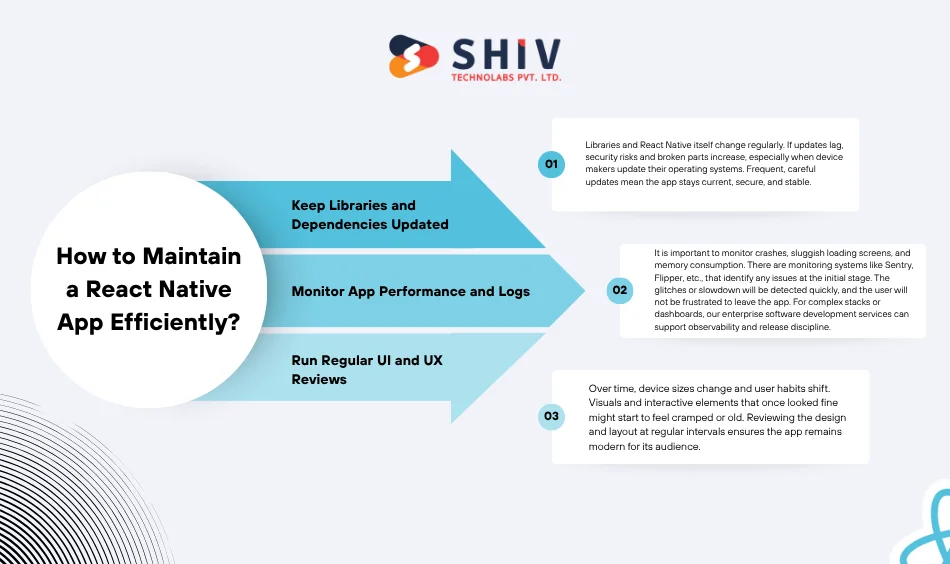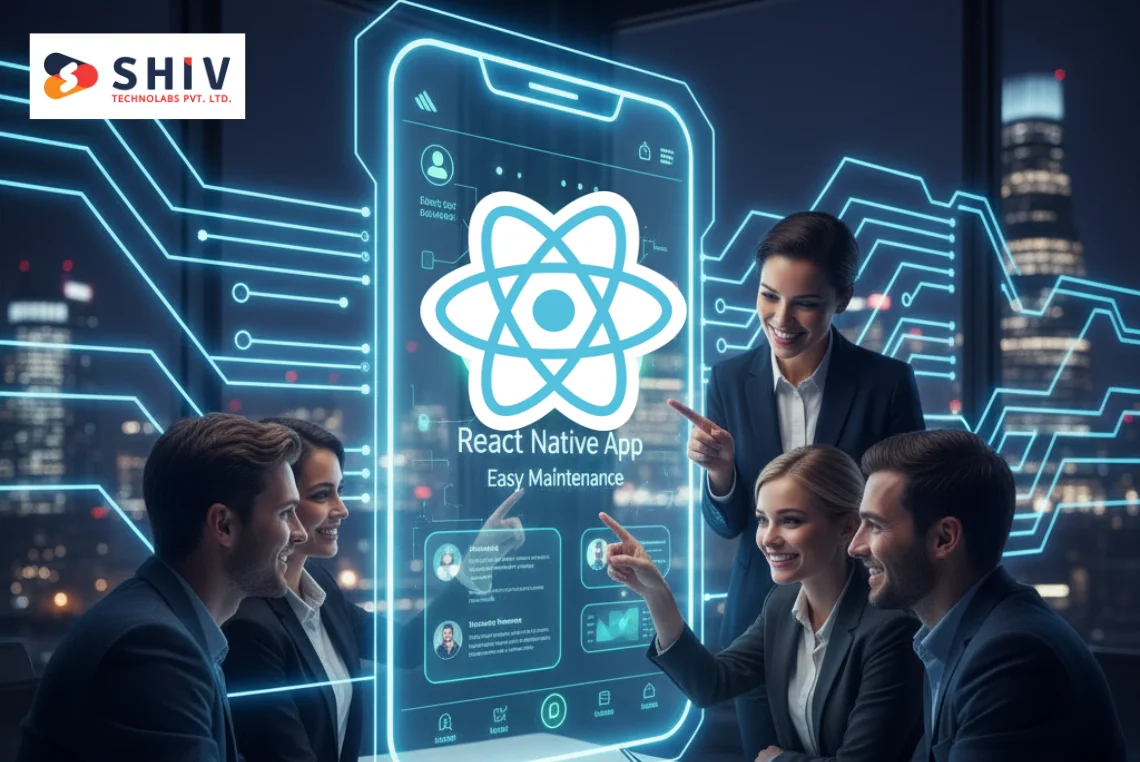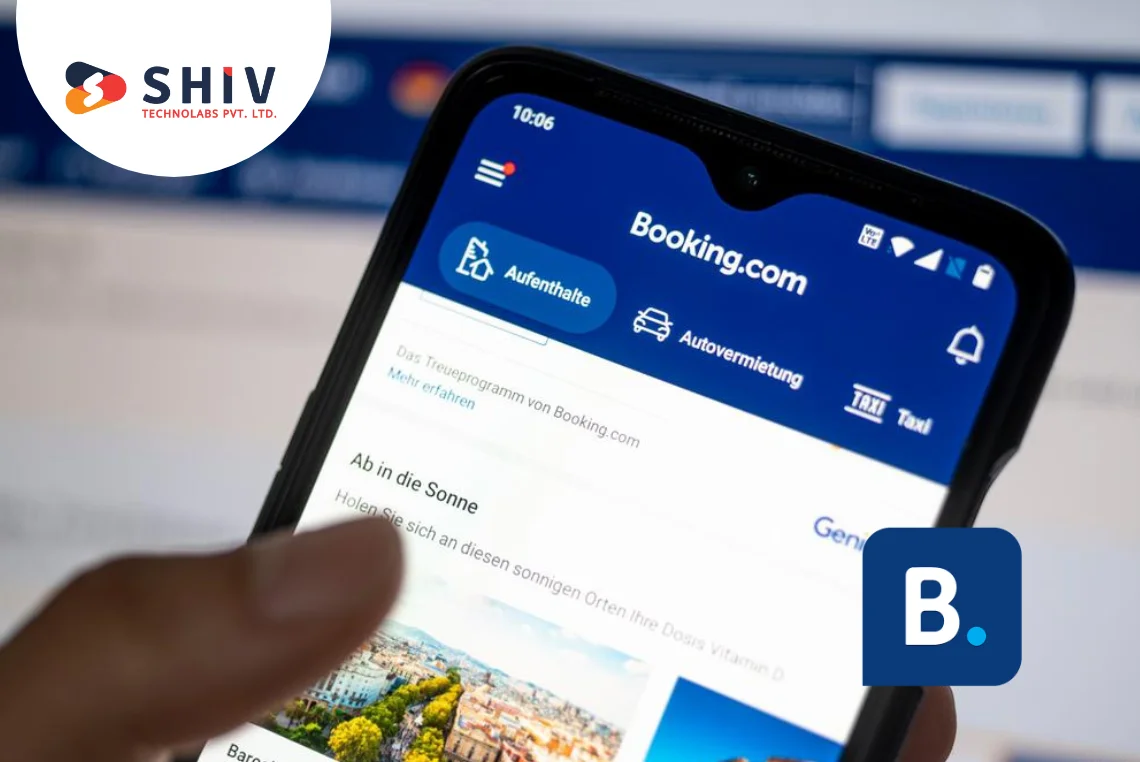Table of Contents
Launching a mobile app is just a basic start in 2025. Maintaining the relevance and app functionality throughout the years is the actual job. Over 90% of users uninstall the app within three months whenever it crashes or fails to work with new phones or operating systems.
React Native is one of the cross-platform frameworks that provide long-term support of mobile apps, as it covers roughly 30-35% of the market. The framework is actively contributed to by many players, ensuring continuous enhancement through updates, improved tools, and new features.
Businesses planning for growth know that the post-launch maintenance costs can easily surpass development expenses.
Thanks to React Native’s single codebase across both platforms and its modular architecture, updates and fixes are delivered faster. The broader community also prevents the codebase from falling behind, helping companies achieve a stronger return over time.
With a React Native app development company like Shiv Technolabs, you get long-term mobile app support and maintenance.
What Makes React Native Stand Out for App Maintenance?
React Native’s main strengths for ongoing support come from its technical structure and community. These points set React Native apart why React Native is good for long-term apps that will last across many device generations and OS cycles.
Shared Codebase
React Native enables developers to create one code for iOS and Android. The developers do not have to modify the code twice when a bug is supposed to be removed or an update is needed for a specific device. This reduces errors, prevents details from diverging, and means faster delivery of features and fixes. When device-specific work is required, our teams cover both sides with Android development and iOS development.
Modular Design and Architecture
The framework is designed for modularity. Developers can separate features, reuse code parts, and build custom modules. That makes it easier to replace, upgrade, or add new parts of the app. When phones get larger screens or new sensors, teams can tweak or swap modules without touching the whole app.
Meta’s Commitment and New Framework Features
Meta continues to support React Native with major upgrades. Features such as the new architecture (Fabric and TurboModules), speed improvements in the Hermes engine, and more reliable JavaScript bridges enable apps to run faster and more efficiently. These adjustments cut down technical debt and improve stability.
React Native can be a brilliant decision in terms of stability and long-term sustainability, made possible through framework improvements, a modular structure, and a robust contribution base, especially when the team collaborates with experienced maintenance providers.
React Native vs Native App Maintenance Costs
Here, we will cover the key difference between the two to determine the cost of maintaining React Native applications:
| Factor | React Native | Native |
|---|---|---|
| Maintenance | Cheaper | Costlier |
| Team | Smaller | Larger |
| Updates | Unified | Separate |
| Libraries | Variable | Stable |
| Compatibility | Easier | Complex |
| Bugs | Shared | Duplicate |
How to Maintain a React Native App Efficiently?

Great maintenance goes beyond solving problems; it involves keeping the app healthy and up to date. The following are the ideal steps to be followed:
Keep Libraries and Dependencies Updated
Libraries and React Native itself change regularly. If updates lag, security risks and broken parts increase, especially when device makers update their operating systems. Frequent, careful updates mean the app stays current, secure, and stable.
Monitor App Performance and Logs
It is important to monitor crashes, sluggish loading screens, and memory consumption. There are monitoring systems like Sentry, Flipper, etc., that identify any issues at the initial stage. The glitches or slowdown will be detected quickly, and the user will not be frustrated to leave the app. For complex stacks or dashboards, our enterprise software development services can support observability and release discipline.
Run Regular UI and UX Reviews
Over time, device sizes change and user habits shift. Visuals and interactive elements that once looked fine might start to feel cramped or old. Reviewing the design and layout at regular intervals ensures the app remains modern for its audience.
Benefits of Regular React Native App Maintenance
A solid maintenance strategy brings real benefits of React Native app maintenance:
Improved Reliability
Steady updates and monitoring reduce crashes, glitches, and performance drops. Users expect their applications to be compatible with the new versions of phones and OS. Don’t neglect updates; instead, address issues as they accumulate.
Faster Reaction to Feedback
If the team listens to users and addresses reviews quickly, bugs and issues get fixed fast. That helps keep users loyal and builds trust.
Compatibility Across Devices and OS
Phones and tablets keep changing. New screens, new hardware, and new software releases—regular maintenance keeps the app running smoothly on all of them, regardless of the changes that arrive.
Brand Consistency
The app represents the company. If performance slips or design quality falls, it harms the overall image. Planned maintenance ensures the app’s appearance and functionality align with the brand’s reputation.
The benefits make ongoing support not just useful but essential for React Native projects.
Challenges in React Native App Maintenance (And How to Overcome Them)

Maintenance is not automatic. React Native presents some challenges, but with thoughtful consideration, you can overcome them. Below are some leading challenges in React Native app maintenance:
Old or Out-of-Date Third-Party Libraries
React Native projects also rely on external libraries, which are used to perform tasks such as navigation and analytics. If libraries get abandoned or lose support, problems arise. Monitor library updates and reputation. Stick with libraries that are active, stable, and popular. When switching or upgrading libraries, test the app to catch major changes or crashes.
Version Mismatches After Updates
Updating React Native, libraries, or OS versions can create bugs or break compatibility. Manage versions with tools like npm or yarn. Automate tests, use staging environments, and update gradually. See our hands-on setup notes for React Native Android environments.
Lagging Performance on Older Devices
New features or heavy code can make older phones run apps slowly. Focus on optimizing code, reducing unnecessary rendering, loading modules only as needed, and using engines like Hermes. Always test on lower-end devices that your users actually use.
Plugin Compatibility Issues
Naturally, not all the plugins will be compatible with the latest React Native architecture or specific OS. To avoid issues with a plug-in, one can build a custom bridge or replace the plug-in. Keep the code minimal, that is, few parts of the app are changed.
Platform-Specific Differences
Even a single codebase does not always behave the same way across iOS and Android. Have separate test suites per platform. With a team of React Native app upgrade experts, familiar with both systems, they build abstractions but allow platform-specific code where needed.
Cost Factors in React Native App Maintenance
Here’s a look at what drives long-term costs and how to estimate them:
Frequency of Updates
More updates mean more testing and development work. Determine a schedule based on user needs and business priorities.
Number of APIs and Integrations
Every outside service, such as payments or maps, is a dependency and will need support when changes happen. More integrations mean more hours spent maintaining the app.
Third-Party Service Use
External APIs and services can charge fees or change their terms. Be ready for both development time and unexpected service costs.
Security and Testing
Protecting data and staying compliant with security rules means regular tests and fixes. Apps with sensitive information or heavy regulations need even deeper security work.
Level of Feature Improvements
Adding new features takes extra work. Some months might only need minor updates, while others include large changes or new functions.
Here is a rough table showing what different levels of cost of maintaining React Native applications:
| Type of Maintenance | Cost Estimate |
|---|---|
| Basic Bug Fixes | $500 – $1,000 |
| Feature Updates | $1,000 – $3,000 |
| Full Support Retainer | $3,000 – $5,000+ |
Why React Native Is Ideal for Long-Term App Projects
If you plan to launch an app that will scale and evolve for years, you need to think beyond just its launch date. In this regard, React Native stands out. This is more than just a cross-platform framework. It is a long-term strategy. Because of the ecosystem’s maturity, Meta’s consistency of updates, and its large developer community, it is a future-proof option. This is why React Native is good for long-term apps. It balances innovation, cost-effectiveness, and reliability.
- Meta regularly updates the framework
- Vast Plugin Ecosystem
- Easy Integration with New Technologies
- Developer accessibility is high
- Maintaining predictable maintenance cycles
- One codebase for better ROI
How to Choose the Right Partner for React Native App Maintenance?
Long-term results can be either made or broken by the right partner, even despite good technology.
Look for a Proven Track Record
Check on the past work of the company, particularly those apps that have been maintained to date, still long after several years: demand case studies, pre-and post-analyses, and client reviews.
Choose a Company with Dedicated Support
True maintenance requires focused attention. The company should offer continuous support with dedicated roles for upkeep, design tweaks, and QA, not just random fixes.
Ask for Clear Pricing and SLAs
Understand what is included in regular maintenance – and what costs extra. Get clear agreements on timelines for fixes, update schedules, and upgrade processes.
Check Experience in Third-Party Integrations
Your partner should also know how to work with libraries, extensions of code, and API, and they must be capable of anticipating the possible pitfalls and avoiding them before they can negatively affect your application.
Evaluate Testing, Version Control, and Code Quality Standards
Powerful partners are those that depend on automated tests, peer code review, and a continuous integration system. These habits help prevent major mistakes and keep updates manageable.
A careful choice ensures the app remains stable and continues to improve, rather than breaking down as changes accumulate.
Reliable React Native Support That Advances with Your Needs
If you’re planning a new app or want to maintain an existing one, expert support is vital. Shiv Technolabs is your ultimate React Native maintenance expert, helping you develop top-class applications without cutting corners on quality.
Our team of experienced developers can:
- Keep your app secure and ready for every OS update, fixing dependency issues before users find them
- Optimize performance without unnecessary spending, using flexible designs and routine checks
- File quick bug fixes and do version upgrades easily, thanks to a deep understanding of your codebase
Reach out to Shiv Technolabs and get support from a React Native team with proven experience in building, updating, and improving mobile apps.
Conclusion
React Native has provided tangible benefits for companies that want to ensure their apps run smoothly over the past few years. Its scalable architecture, frequent releases, and broad ecosystem allow reducing technical debt and improving performance, despite new devices and operating systems coming into view. Shiv Technolabs is the premier React Native app development company, helping brands create top-notch applications that prioritize user experience while offering comprehensive end-to-end support.
At Shiv Technolabs, it is not just about launching new apps. As a React Native app development company, we handle ongoing maintenance, upgrades, and improvements, ensuring every project remains responsive and reliable. By choosing Shiv Technolabs as your dedicated React Native development team, you can rest assured that you will work with professionals who are committed to taking care of every aspect of maintenance and achieving improved outcomes in the long run.
A long-term React Native support partnership should be considered by businesses seeking long-term, affordable, and powerful mobile apps.
FAQs
Q1. What is the typical cost for React Native app maintenance?
Prices are based on such factors as the complexity of the application, the number of features, and its frequency of updates. Simple applications cost approximately $500 to $1000 per month in basic repair. Apps with more users and features may see costs move past $5,000 monthly.
Q2. How often should a React Native app get updated?
Updating every three to six months is standard. This keeps the app compatible with new phone models and operating system updates, and meets changing user needs. Security issues or serious bugs might need even faster updates.
Q3. Can React Native support teams manage major version upgrades?
Yes. Experienced teams study changes, build scripts for smooth migration, test upgrades on staging devices, and roll them out carefully. Good planning means less downtime and better stability for all users.
Q4. What are the toughest challenges in React Native app maintenance?
These include outdated third-party tools, update conflicts, slower performance on older devices, and plugin issues. Addressing these problems requires routine monitoring, a strong code structure, and expert assistance.
Q5. Why hire a dedicated React Native development team?
A regular team familiar with the codebase will result in quicker fixes, improved structure, reduced risk, and consistent performance. Through such committed support, the business will be able to implement features, maintain quality, and manage long-term expenses without the need to face emergencies all the time.





















